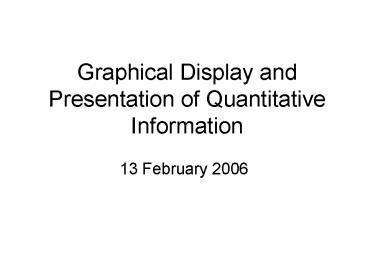Graphical Display and Presentation of Quantitative Information - PowerPoint PPT Presentation
Title:
Graphical Display and Presentation of Quantitative Information
Description:
What goes into making a good figure? ... be useful Avoid pie-charts ... 10 minutes Develop your elevator speech No text smaller than 24 point More tips ... – PowerPoint PPT presentation
Number of Views:59
Avg rating:3.0/5.0
Title: Graphical Display and Presentation of Quantitative Information
1
Graphical Display and Presentation of
Quantitative Information
- 13 February 2006
2
What goes into making a good figure?
- Based on the work of Edward R. Tufte, The Visual
Display of Quantitative Information - At their best, graphics are instruments for
reasoning about quantitative information
Napoleons Russian campaign, shown by C. J. Minard
3
Graphical Excellence
- Basic philosophy
- Assume your audience is intelligent
- Developing an excellent graphic takes hard work
- Most graphs, like many other endeavors follow the
80-20 Rule You can get it 80 done with 20 of
the effort, but the remaining 20 is hard work,
and takes the remaining 80 of the effort.
4
Clarify by adding more detail, not less
5
Plots should be data-rich
- Maximize data-ink
- Data Density (no. of entries in data
matrix)/(area of graphic) - Data Ink Ratio (data-ink)/(total ink in the
plot) - Use multiples for comparisons
- Visual metaphors can be useful
- Avoid pie-charts -- they are low in data density
and do not order data along a visual dimension
6
Trellis diagram showing barley production at
different sites for two years (1931 and
1932) The data are the yields for all
combinations of site, variety, and year Small
multiples are inevitably comparative
7
Avoid chart junk
- Chart elements in close proximity create a visual
interaction (113) - Avoid using moiré patterns, optical vibration
(e.g. cross-hatching)
8
- Where possible, use direct labelling instead of
legends - Use horizontal text
- Avoid abbreviations
9
(No Transcript)
10
Present Real Data
- Visual metaphors are helpful too
11
The Lie Factor
- "The representation of numbers, as physically
measured on the surface of the graphic itself,
should be directly proportional to the quantities
represented."
12
Plots should be
- Comparative
- Multivariate
- High density
- Able to reveal interactions, comparisons, etc
- And where nearly all of the ink is actual data
ink - Small multiples can be visually effective
13
/Example of a good poster http//cires.colorado.ed
u/brodzik/2005agu/2005agu_pits.pdf
14
Ask the right questions
- Does the display tell the truth?
- Is the representation accurate?
- Are the data documented?
- Do the display methods tell the truth?
- Are appropriate comparisons, contrasts, and
contexts shown?
15
(No Transcript)
16
Slideware is Evil
- Power corrupts, PowerPoint corrupts absolutely
(Tufte, 2003) - Presentations should serve the audience, not the
speaker - It should supplement the presentation, not be the
presentation
17
(No Transcript)
18
Some tips
- Maintain high data density without excessive text
- Do not abbreviate statements to the point that
they dont make sense - Bullet lists do not explain multi-dimensional
relationships so try to use graphics - Do not use the AutoContent Wizard!
19
If Abe Lincoln had had Power Point
- http//www.norvig.com/Gettysburg/
20
Designing Scientific Posters
The poster is a large document, not just
decorative
It contains an Introduction that motivates the
reader to continue. List the research objectives
Figures are large and clearly labeled
Use graphics to show your Results
State your conclusion and be sure they are tied
to the objectives References Acknowledgements
The Methodology section should be short but
contain sufficient detail
21
Making your poster presentation matter
- Make the title both informational and interesting
- Use color and symmetry to make your poster
beautiful - Someone should be able to read the entire poster
in less than 10 minutes - Develop your elevator speech
- No text smaller than 24 point
22
More tips
- The printed version may look different from the
computer screen version - Computer graphics use color additive process
(RGB) whereas printers use a color subtractive
process (CMYK) - Printers dont have as many color combinations as
computers - Avoid using saturated colors
- Avoid using low-resolution graphics
23
Your professional demeanor
- No gum
- Avoid annoying mannerisms
- Dress appropriately
- Show up!
- Look at your audience when you are speaking,
thank them, shake hands - Provide letter-sized color copies
- Bring business cards
- Follow up on requests for information
- http//www.swarthmore.edu/NatSci/cpurrin1/posterad
vice.htm































